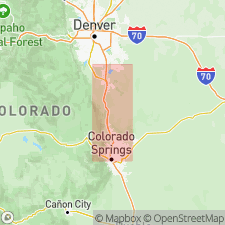
- Usage in publication:
-
- Denver Basin Group
- Modifications:
-
- Original reference
- AAPG geologic province:
-
- Denver basin
Summary:
Denver Basin Group. Sequence of synorogenic strata lying above unconformity at top of Laramie Formation and below unconformity at base of Eocene Larkspur Conglomerate, Wall Mountain Tuff, or Castle Rock Conglomerate. [= restricted Denver Basin aquifer system.] In Colorado Springs area, El Paso County, eastern Colorado, includes (descending): Dawson Arkose, and newly named Black Squirrel Formation, Jimmy Camp Formation, Pulpit Rock Formation, and Pikeview Formation. In Castle Rock area, includes (descending) Dawson Arkose and Denver Formation. In Denver area, includes (descending) Dawson Arkose, Denver Formation, and Arapahoe Formation. Age is Late Cretaceous, Paleocene, and Eocene.
[Recognized in same general area as the Denver Basin aquifer system (see USGS Groundwater Atlas of the U.S., HA 730-C, fig. 80); in area east of the Rocky Mountains, eastern CO, from Greeley, Weld Co., southward to Colorado Springs, El Paso Co., and as far east as Limon, Lincoln Co. Probably named from Denver basin (Denver-Julesburg basin), an asymmetrical bowl-shaped geologic structural basin in the Interior Plains (Colorado Piedmont) physiographic province.]
Source: Publication.
For more information, please contact Nancy Stamm, Geologic Names Committee Secretary.
Asterisk (*) indicates published by U.S. Geological Survey authors.
"No current usage" (†) implies that a name has been abandoned or has fallen into disuse. Former usage and, if known, replacement name given in parentheses ( ).
Slash (/) indicates name conflicts with nomenclatural guidelines (CSN, 1933; ACSN, 1961, 1970; NACSN, 1983, 2005, 2021). May be explained within brackets ([ ]).

